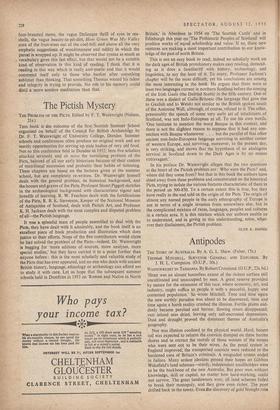The Pictish Mystery
THE PROBLEM OF THE PICTS. Edited by F. T. Wainwright (Nelson, 21s.) THIS book is the outcome of the first Scottish Summer School organised on behalf of the Council for British Archaeology by Dr. F. T. Wainwright of University College, Dundee. Summer schools and conferences often produce no original work and are merely opportunities for serving up stale hashes of very old food. Not so this conference held in Dundee in 1952; here five scholars attacked seriously and de novo the tantalising problem of the Picts,,beloved of all our early historians because of their custom of niatrilineal succession and probably their habits of tattooing. These chapters are based on the lectures given at the summer school, but are completely re-written. Dr. Wainwright himself deals with the general problem, its historical background, and the houses and graves of the Picts. Professor Stuart Piggott sketches in the archwological background with characteristic vigour and breadth of learning. R. W. Feachem deals with the fortifications of the Picts, R. B. K. Stevenson, Keeper of the National Museum of Antiquities of Scotland, deals with Pictish Art, and Professor K. H. 'Jackson deals with the most complex and disputed problem of all—the Pictish language.
It was a splendid team of people assembled to deal with the Picts, they have dealt with it admirably, and the book itself is an excellent piece of book production and illustration which does justice to their efforts. None of the five contributors would claim he had solved the probleni of the Picts—indeed, Dr. Wainwright is begging for `more editions of sources, more analyses, more special studies,' but they have carried it to a point further than anyone before : this is the most scholarly and valuable study of the Picts that has ever appeared, and no one who deals with ancient British history, language, ethnology or archaeology can afford not to study it with care. Let us hope that the subsequent summer schools held in Dumfries in 1953 on 'Roman and Native in North Britain,' in Aberdeen in 1954 on 'The Scottish Castle' and in Edinburgh this year on `The Prehistoric Peoples of Scotland' will produce works of equal scholarship and value. If so, these new ventures are making a most important contribution to our know- ledge of the past of north Britain.
This is not an easy book to read; indeed no scholarly work on the dark ages of British protohistory makes easy reading, demand- ing as it does a familiarity with history. archaeology, and linguistics, to say the least of it. To many, Professor Jackson's chapter will be the most difficult; yet his conclusions arc among the most interesting in the book. He argues that there were at least two languages current in northern Scotland before the coming of the Irish Gaels (the Dalriad Scotti) in the fifth century. One of these was a dialect of Gallo-Britonic (the language that gave rise to Gaulish and to Welsh) not similar to the British spoken south of the Antonine Wall, although, of course, related to it. The other, presumably the speech of some very early set of inhabitants of Scotland, was not Indo-European at all. To use his own words, `One hesitates to mention the word Basque in this context, and there is not the slightest reason to suppose that it had any con- nection with Basque whatsoever . . . but the parallel of that other ancient non-Indo-European language surviving in another corner of western Europe, and surviving, moreover, to the present day, is very striking, and shows that the hypothesis of an analogous survival in Scotland down to the Dark Ages is by no means extravagant.'
In his preface Dr. Wainwright alleges that the two questions at the heart of the Pictish problem are : Who were the Picts? and, where did they come from? but that in this book the authors have shied away from these problems and concentrated on the historical Picts, trying to isolate the various features characteristic of them in the period AD 300-850. To a certain extent this is true, but they have really in the end told us the origin of the Picts. The origin of almost any named people in the early ethnography of. Europe is not in terms of a single invasion from somewhere else, but in the complicated mixture of races, languages, peoples and cultures in a certain area. It is this mixture which our authors enable us to understand, and in giving us this understanding, solve, what- ever their disclaimers, the Pictish problem.
GLYN E. DANIEL


































 Previous page
Previous page